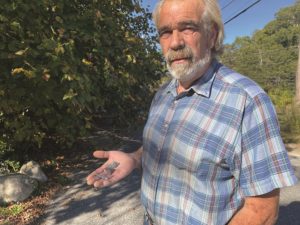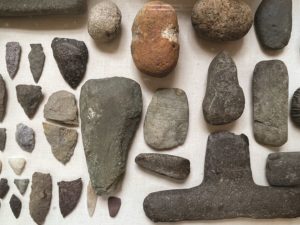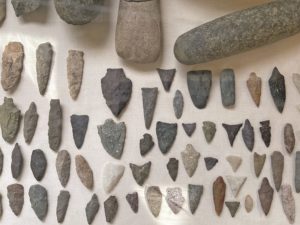If you’re looking for treasure, Mike Parlante has some advice for you: “Look down.” That’s how he found the majority of the Native American artifacts currently on display at the Wellfleet Historical Society and Museum as part of the exhibit “Collecting Wellfleet.”
Parlante, a longtime Wellfleet local who works his own aquaculture grant, recently donated two display cases full of arrowheads, grinding stones, and tools to the museum, about 100 pieces in all. Parlante, who also has an impressive art collection, says the Native American artifacts represent several decades of collecting and several thousand years of history.

Parlante is not a deep digger. His collection consists mostly of surface finds out on the flats or unearthed by recent land development. “When I go out in the woods, I look for areas where they’re building a house or putting a road in, where there’s erosion,” he explains.
He walks, head down, eyes sharp, looking for evidence — specifically, stone flakes from tool-making that tell him there’s something there. “You have to trance yourself out a little bit,” he says. “You go into this sort of trance and then you start noticing chips and seeing the flakes.
“Ever since I was a kid,” he continues, “I was always interested in the Wampanoag people, and about finding arrowheads and artifacts. I had Frank James as a music teacher when I was a little kid.”
James, who was also known as Wamsutta, was the leader of the Wampanoag tribe in 1970 when he called for Thanksgiving to be a national day of mourning for indigenous peoples. He was also a revered music teacher in the Nauset schools, who regaled students with stories of finding arrowheads.
“He had an old orange Corvette that had a bumper sticker on the back that said, ‘Custer Had It Coming,’ ” recalls Parlante. “I felt so proud to ride in that thing.”

When Parlante was in high school, James took him out many times to hunt for artifacts. “He told me what to look for,” Parlante says. James taught him how to read the terrain for evidence of ancient habitation. “You’re looking for a black line in the soil, which usually means the original layer where people once lived.”
One piece in the collection is a deer antler, found on Taylor Hill near the Harborside Village mobile home park, that James told him was used for flaking arrowheads. “The whole hill was a major encampment for Indians,” says Parlante. “All around those little ponds in the Taylor Hill area — it’s all loaded with shell middens, so it was a lot of people eating shellfish out there.” The middens are half an acre across, and several feet deep.
The pieces in the Historical Society collection are from all over Wellfleet — the harbor flats, Blackfish Creek, Lieutenant Island. Some can be dated by examining their size and shape. But, says Parlante, “many of them are beach finds, so they are difficult to date because of erosion.
“The most impressive point I have is a crescent-shaped arrowhead with a little curve in it,” he says. “That’s a 10,000-year-old point I found on Lieutenant Island. That was back when the sea level was down approximately 200 feet from where it is now. I’ve got other ones that are 6,000 to 7,000 years old.”
The arrowheads are made from quartz, chert, and other quartz-like stones that flake easily. “I found one flint arrowhead down by Blackfish Creek,” says Parlante. “You don’t see that around here.” It was most likely the result of trade with other tribes, he speculates.

Though arrowheads are more ubiquitous, Parlante has also uncovered pestles and stones with time-worn grooves for sharpening bones or sticks. “This little axe right here,” he says, gesturing to a fractured stone blade. “I found the two parts a year apart and they fit perfectly together.” Parlante also found three arrowheads, years apart, that were all the same shape and size, indicating one person was responsible for their manufacture.
Repatriation is important for Parlante. He makes sure, whenever possible, that artifacts remain in the area from which they came. “Once this stuff leaves the area it’s from, it has disappeared,” he says. “It should stay in the town where it was found and put on display. There’s history behind them. These are the people that were here, and are still here, and made these things.”
Stone’s Throw
The event: “Collecting Wellfleet”
The time: By appointment; call 508-349-9157
The place: Wellfleet Historical Society and Museum, 266 Main St.
The cost: Free
